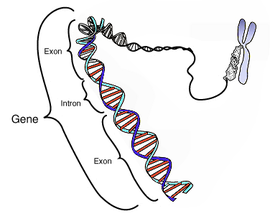Still working to recover. Please don't edit quite yet.
Misconceptions about the gene sequence
During the latter half of the 20th century, the fields of Wikipedia:genetics and Wikipedia:molecular biology matured greatly, significantly increasing understanding of biological Wikipedia:heredity.[2][3][4][5] As with other complex and evolving fields of knowledge, the public awareness of these advances has primarily been through the mass media Wikipedia:mass media, and a number of common misunderstandings of genetics have arisen. Common misunderstandings include the following ideas:
Genetic determinismWhile there are many examples of animals that display certain well-defined behaviour that is genetically programmed,[6] these examples have been extrapolated to a popular misconception that all patterns of behaviour, and more generally the Wikipedia:phenotype, are rigidly genetically determined. There is good evidence that some basic aspects of human behaviour, such as Wikipedia:circadian rhythms[7] are genetically-based, but it is clear that many other aspects are not. In the first place, much phenotypic variability does not stem from genetics. For example:
A gene for XIn the early years of genetics it was suggested that there might be "a gene for" a wide range of particular characteristics. This was partly because the examples studied from Mendel onwards inevitably focused on genes whose effects could be readily identified; partly that it was easier to teach science that way; and partly because the mathematics of evolutionary dynamics is simpler if there is a simple mapping between genes and phenotypic characteristics.[9] These have led to the general perception that there is "a gene for" arbitrary traits,[10] leading to controversy in particular cases such as the purported "gay gene".[11] However, in light of the known complexities of gene expression networks (and phenomena such as epigenetics), it is clear that instances where a single gene "codes for" a single, discernible phenotypic effect are rare, and that media presentations of "a gene for X" grossly oversimplify the vast majority of situations. Genes as a blueprint This stylistic schematic diagram shows a gene in relation to the double helix structure of Wikipedia:DNA and to a Wikipedia:chromosome (right). Wikipedia:Introns are regions often found in Wikipedia:eukaryote genes which are removed in the splicing process: only the Wikipedia:exons encode the Wikipedia:protein. This diagram labels a region of only 40 or so bases as a gene. In reality most genes are hundreds of times larger and have several Introns, sometimes over 100 It is widely believed that genes provide a "blueprint" for the body in much the same way that architectural or Wikipedia:mechanical engineering blueprints describe buildings or machines.[12] At a superficial level, genes and conventional blueprints share the common property of being low Wikipedia:dimensional (genes are organised as a one-dimensional string of Wikipedia:nucleotides; blueprints are typically two-dimensional drawings on paper) but containing information about fully three-dimensional structures. However, this view ignores the fundamental differences between genes and blueprints in the nature of the mapping from low order information to the high order object. In the case of biological systems, a long and complicated chain of interactions separates genetic information from Wikipedia:macroscopic structures and functions. The following simplified diagram of causality illustrates this:
Even at the small scale, the relationship between genes and proteins (once thought of as "Wikipedia:one gene, one polypeptide")[13] is known to be complicated, with approximately 5 proteins in the human body for each gene. More significantly, the causal chains from genes to functionality are not separate or isolated but are entangled together, most obviously in Wikipedia:metabolic pathways (such as the Calvin and citric acid cycles) which link a succession of Wikipedia:enzymes (and, thus, gene products) to form a coherent biochemical system. Furthermore, information flow in the chain is not exclusively one-way. While the Wikipedia:central dogma of molecular biology describes how information cannot be passed back to inheritable genetic information, the other causal arrows in this chain can be Wikipedia:bidirectional, with complex feedbacks ultimately regulating Wikipedia:gene expression. Instead of being a simple, linear mapping, this complex relationship between genotype and phenotype is not straightforward to deconvolute. Rather than describing genetic information as a blueprint, some have suggested that a more appropriate Wikipedia:analogy is that of a Wikipedia:recipe for Wikipedia:cooking,[14] where a collection of Wikipedia:ingredients is combined via a set of instructions to form an emergent structure, such as a cake, that is not described explicitly in the recipe itself. Genes as wordsIt is popularly supposed that a gene is "a linear sequence of nucleotides along a segment of DNA that provides the coded instructions for synthesis of RNA"[15] and even some current medical dictionaries define a gene as "a hereditary unit that occupies a specific location on a chromosome, determines a particular characteristic in an organism by directing the formation of a specific protein, and is capable of replicating itself at each cell division."[16] In fact, as the diagram illustrates schematically, genes are much more complicated and elusive concepts. A reasonable modern definition of a gene is "a locatable region of genomic sequence, corresponding to a unit of inheritance, which is associated with regulatory regions, transcribed regions and/or other functional sequence regions."[17] One of the major complicating factors is that the Wikipedia:exons which code for the proteins are often separated by many Wikipedia:introns, which used to be called "Wikipedia:junk DNA" but appear to have various as-yet-ill-understood purposes. The exons can be combined in different orders (Wikipedia:splice variants) to produce different proteins. For example the gene called Wikipedia:Dscam in Wikipedia:Drosophila has 110 introns and therefore tens of thousands of possible splice variants.[18] This kind of misperception is perpetuated when mainstream media report that an organism's genome has been "decyphered" when they mean that it has simply been sequenced.[19] A related misconception is that the sole function of genes is to code for proteins, with the non-coding remainder being "Wikipedia:junk DNA". However, it now appears that, although protein-coding DNA makes up barely 2% of the Wikipedia:human genome, about 80% of the bases in the genome may be being expressed, so the term "junk DNA" may be a misnomer.[20] References
|
||||||||